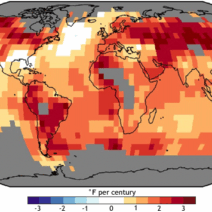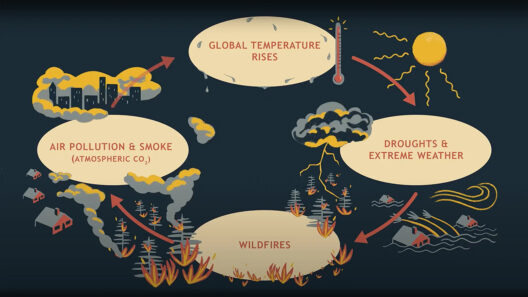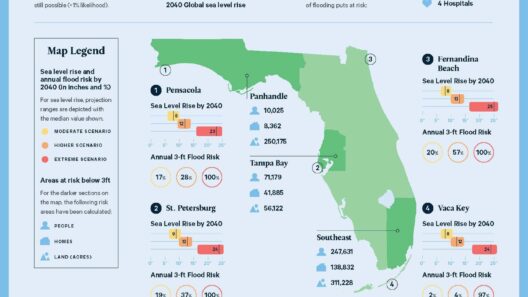Climate change, an existential crisis that looms over our planet, engenders a plethora of consequences that extend far beyond the incremental rise in global temperatures. One profound effect is the domino effect—an interlinked series of events that trigger subsequent challenges, all cascading from the initial repercussions of climate change. This article elucidates how this domino effect manifests across various ecosystems and societal structures, examining the intricate web of interdependencies that characterizes our planet.
At the apex of the domino effect lies the warming of our planet, predominantly resulting from anthropogenic greenhouse gas emissions. As temperatures rise, glacial ice and polar ice caps, which have accumulated over millennia, begin to melt at an accelerated rate. This phenomenon not only contributes to rising sea levels but also disrupts the salinity and temperature of oceans, which are vital to maintaining marine biodiversity.
The melting of ice caps leads to a significant elevation in sea levels, posing an imminent threat to coastal communities worldwide. For instance, cities from New Orleans to Venice are increasingly vulnerable to flooding, erosive phenomena, and storm surges. The inundation of habitable areas forces populations to migrate and adapt, causing urban displacement. Such demographic shifts can lead to heightened tension over resources and exacerbate existing social tensions.
Furthermore, the alteration in sea levels promotes saltwater intrusion into freshwater ecosystems. A prime example of this can be seen in the deltas of major rivers, where agricultural activities are often concentrated. As salinewaters infiltrate the land, crops that are not salt-resistant begin to dwindle, affecting food security. A consistent food supply is crucial for societal stability; hence, agricultural depletion can lead to economic turmoil and the potential for civil unrest as communities grapple with food scarcity.
Beyond agricultural impact, the alteration of marine ecosystems has profound implications for global fish populations. As ocean temperatures rise, species migration patterns are disrupted, resulting in changes to fish distribution. Commercial fisheries, heavily reliant on specific fish stocks, face declining yields as traditional fishing grounds become less productive. Consequently, not only does this affect livelihoods, but it also threatens the intricate balance of marine food chains, potentially leading to the collapse of certain species and subsequent shifts in ecosystem dynamics.
The impact of climate change extends to terrestrial biomes as well. Ecosystems such as forests and grasslands are particularly susceptible to shifts in climate conditions, leading to altered species composition and productivity. For instance, warmer temperatures may enhance the growth of certain tree species while diminishing others, consequently affecting local fauna that rely on those plants for sustenance. Moreover, this alteration fosters the proliferation of invasive species, which outcompete native flora and fauna, disrupting the ecological balance further.
The domino effect also transpires through intensified weather events, including hurricanes, droughts, and wildfires. The frequency and intensity of these natural occurrences have been exacerbated by climate change, leading to catastrophic consequences. For example, droughts diminish water availability, affecting not just agricultural irrigation but also municipal water supply and hydropower generation. This multi-faceted impact strains resources, fostering potential conflicts over access to freshwater resources.
Additionally, the increasing frequency of wildfires, driven by hotter and drier conditions, ravages forests, contributes to habitat loss, and generates substantial carbon emissions. The release of stored carbon further accelerates the greenhouse effect, creating a vicious cycle that exacerbates global warming. As this cycle continues, it becomes increasingly challenging for societies and ecosystems to adapt, creating a perpetual state of instability.
Addressing the domino effect requires a multifaceted approach, engaging various stakeholders ranging from government entities and scientific communities to grassroots organizations and individual citizens. Mitigation strategies, including promoting renewable energy sources, enhancing energy efficiency, and advocating for sustainable agricultural practices, are fundamental in combating the root causes of climate change.
Moreover, adaptation strategies must be equally prioritized. Building resilient infrastructures, developing drought-resistant crops, and establishing sustainable water management practices are just a few examples of how communities can shield themselves from the cascading effects of climate change. Engaging in cooperative international efforts can also foster broader paradigms in responding to climate challenges that transcend national borders.
Understanding the domino effect of climate change enables a clearer perspective of how interlinked our ecosystems and societies are. The initial changes set off a chain reaction, with repercussions that can reverberate through every aspect of life on Earth. As such, this entails urgent action and vigilance to create holistic policies that not only address immediate crises but also consider long-term sustainability. The intricate symbiotic relationships that characterize our biosphere necessitate a collective response, nurturing not only our planet’s immediate health but also its future viability.
In conclusion, the domino effect of climate change underscores the importance of proactive measures across multiple sectors. The cascading consequences are not isolated phenomena; rather, they demonstrate the interconnectedness of ecological, social, and economic systems. By acknowledging and addressing these links, society can foster resilience and adaptability in the face of a rapidly changing climate.







